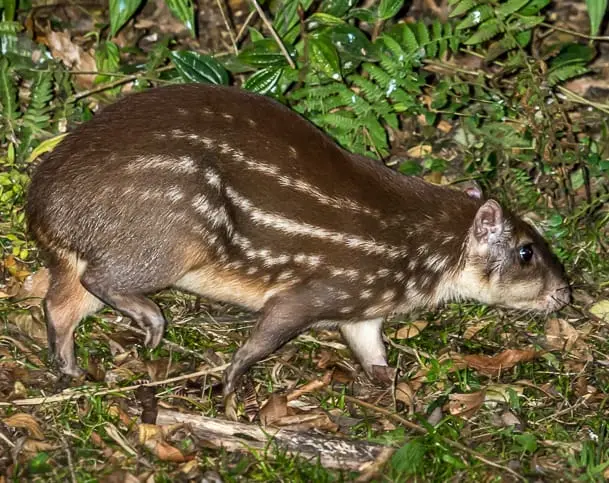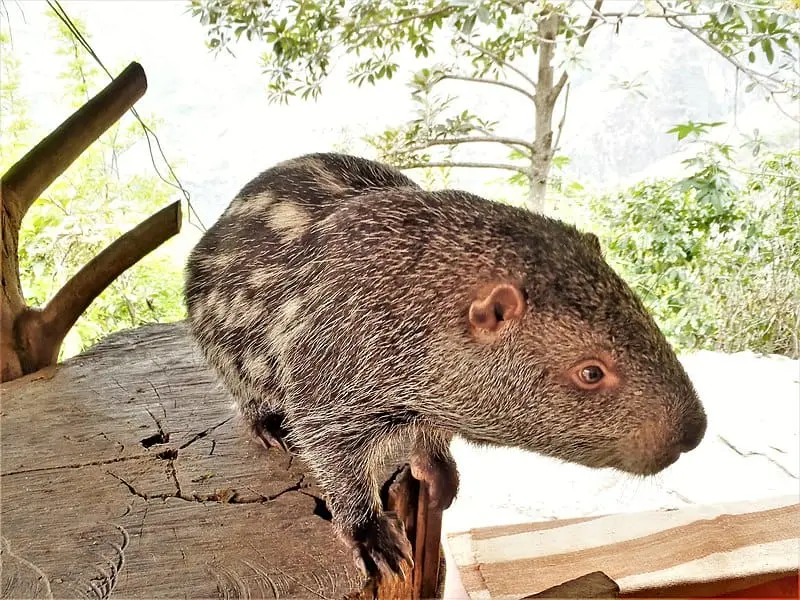Pacas, pacaranas, agoutis, and acouchis
To many, pacas, pacaranas, agoutis, and acouchis can be very similar animals, and are often confused with each other. They are all part of the same group called Caviomorpha, but belong to different families, which makes them easily identifiable. Knowing the difference between these animals is an important way to learn about them, appreciate the local fauna, and help preserve it.
Paca (Cuniculus paca)

They are large rodents with fur that varies from dark gray to red, always with white patches along the sides of the body. They have large, sharp claws that help them dig their burrows in damp places near forested rivers, where they sleep most of the day and come out only at night.
Pacas (as well as some marsupials, bats, and primates) have a behavior called " lunar phobia" that causes them to avoid environments that are illuminated by moonlight. They prefer to forage during waning moon nights when the sky is darker - it seems safer to search for leaves, flowers and especially fallen fruit.
During this time, pacas can travel up to 14 km (9 miles) in a single night in search of food, using their excellent memory to follow only the safest paths they have already traveled.
Despite their seemingly stubby body, pacas are very agile and have excellent senses. They are alert at all times and are extremely shy and cautious - always running and hiding when they hear a suspicious noise or approach. Because they swim very well, they can dive and stay underwater for several minutes, even using submerged air pockets if necessary.
They are considered one of the most important dispersers of seeds. They also play an important role in the food chain, being one of the main prey for large predators such as pumas and jaguars.
It is often targeted by hunters for its highly prized meat. Despite this, it is not considered an endangered species except in the state of Paraná. Although the hunting and capture of pacas is prohibited, they can be bred in captivity with proper authorization from Brazilian Institute of Environment and Renewable Natural Resources (Ibama).
Pacarana (Dinomys branickii)

The pacarana is the third largest rodent in the world, after the capybara and the beaver. Its name means “false paca” or “similar to a paca”. Although they may look similar, pacaranas belong to a completely different family and are easily distinguished by their long tails, dark coloration, and more robust head and body. They also tend to be heavier and slightly larger than pacas.
Pacaranas also live near water and have an interesting system of burrows and tunnels: each family uses up to eight burrows. In a separate area are the latrines and, separately, the place where they feed on various leaves and stems. Each burrow has several exits, and each area (the burrows, the latrines, and the feeding area) is connected by several underground tunnels.
Because they walk slowly, even when they go out to feed at night, they do not usually take long walks. They always feed on what is available nearby, and when food becomes scarce, the group moves on. Although they build and live in burrows, they are excellent climbers, and captive pacaranas prefer to climb trees to sleep.
Like pacas, they are excellent seed dispersers and also help control the overgrowth of certain plants. They are also an important food source for predators. Pacaranas have always been rare animals, so rarely seen that their extinction has sometimes been considered.
Due to their slow reproduction, poaching and habitat loss, they are vulnerable to extinction. In Brazil, they are found only in Acre and western Amazonas.
Agouti (Dasyproctidae sp.)

Unlike pacas and pacaranas, agoutis are spotless and smaller, weighing up to 7 kg (15 lb) and measuring up to 70 cm (27 in) long. There are about seven species of agoutis scattered throughout Brazil’s biomes, differing mainly in their coat color, which can range from golden to dark brown.
Agoutis are very shy and agile, running so fast at the slightest sign of danger that they can easily outwit predators and hunters. This ability is due to the fact that their hind legs are longer and stronger than their front legs. This trait also makes them great jumpers, capable of jumping up to 2 meters (6.5 ft).
In areas where they are not hunted, they are active throughout the day, but in risky areas they are only seen at twilight. They live in burrows built under roots, in hollow fallen trees, and in ravines. They usually live in pairs, but can congregate in groups of up to 100 individuals to feed on leaves, roots, and especially fallen fruit.
They have such good hearing that they can find fruit just by hearing it fall from the trees. When storing food, they usually bury fruits and nuts for the lean months. In this way, Agoutis end up planting hundreds of seeds and are great dispersers of fruit trees.
Deforestation and illegal hunting are the main threats to their existence. As a form of conservation, they are often kept in captivity by organizations such as the Center for the Study and Conservation of Wild Animals (Nepas).
Acouchi (Myoprocta sp.)

Of all the animals mentioned here, the Acouchi is probably the least known. Acouchis are part of the same family as Agoutis, but belong to another genus. Although they are often confused, Acouchis are smaller - at only 35 cm (13 in) and 1.5 kg (3.5 lb). In addition, the easiest way to identify them is by having a small tail of no more than 7 cm (3 in) with a tuft at the tip - whereas Agoutis have virtually no tail. For this reason the acouchis are also called tailed-agoutis.
There are two species that inhabit the northern region of Brazil, in much of the Amazon rainforest. The most obvious difference between the two is their coloring: the red acouchi (M. acouchy) is red with a black back, and the green acouchi (M. pratti) has a mixture of brown, red and golden hairs interspersed, which can give the impression of having a greenish coloring.
They usually sleep in hollow fallen trees near rivers and do not dig their own burrows, but live in burrows they find already dug by other animals (mainly armadillos). They are solitary and diurnal. Their diet consists mainly of insects and fruits that they hear falling from the trees.
Only in recent decades has the acouchi been described as a separate genus from the agoutis, rather than as a subspecies of the latter. Very little is known about these animals, and studies of their populations and conservation status have yet to be conducted.
Caviomorph rodents are important seed dispersers and ensure the maintenance and regeneration of local flora. Despite their ecological importance, there are gaps in our knowledge of their ecology and the impact of human activities on their conservation.
Because some species have few individuals and because of their unusual behavior, it is a challenge for researchers to obtain more information about these animals in their habitat. More studies are needed on their taxonomic classifications, ecology, threats, and conservation options so that we can better understand our wildlife and how to conserve it.
Read more at:
Uso de Habitat e Ocorrência de Roedores Caviomorfos na Amazônia Central, Brasil
Dasyprocta azarae - Azara’s Agouti
Descrição das categorias de comportamentos do Dasyprocta prymnolopha em condições de cativeiro
Paca: Que animal é esse? Vamos conhecer esse animal que tem hábitos noturnos
